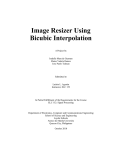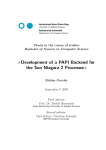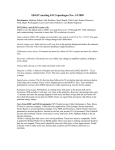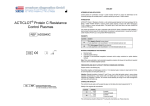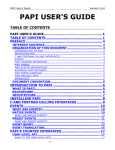Download epframes - XMM-Newton
Transcript
XMM-Newton Science Analysis System
Page:
1
epframes
November 4, 2014
Abstract
This task reformats the EPIC ODF PN events list into the file format required
by subsequent off-line analysis. epframes converts frame numbers to event specific
time tags. It determines invalid events and frames and creates corresponding GTI
files per CCD. In addition, epframes appends the CCD specific exposure extension
to the output event list. Optionally, auxiliary information for cosmic ray analysis is
collected.
1
Instruments/Modes
Instrument
EPIC PN
2
Use
pipeline processing
interactive analysis
3
3.1
Mode
IMAGING, TIMING, BURST
yes
yes
Description
General
epframes reads a raw event list of a single CCD and exposure from an EPIC PN ODF ([1]) 1 . The
input file is specified giving the actual filename or a symbolic form of it (which will be expanded with
OAL expandFileName). The ODF in use is defined via the SAS environment variable SAS ODF prior to
execution. epframes uses the summary file from the ODF to display info about the selected observation
and to fill in standard header keywords. The auxiliary, main periodic housekeeping and spacecraft time
correlation files corresponding to the selected EPIC PN raw event list are needed for the computation of
event time tags.
1 Note, that according to oal the exposure number is the actual running number of the exposure in that particular
instrument mode, e.g. OAL(EPN, IMAGING, 14, 11) means the task is looking for CCD 11 of the 14th imaging mode
exposure of EPIC-pn in the ODF while ODF(EPN, IMAGING, 2, 11, U) stands for an unscheduled observation with
exposure identifier PNU002.
XMM-Newton Science Analysis System
Page:
2
epframes flags events with faulty coordinates or times in a FLAG column. The flags are bit-masked
following the same code as for the MOS (see [5]). epframes stores statistics about these wrong events in
FITS keywords (WRGCOORD, WRGORDER and WRGTIME) in the output event list. The statistics of bad frames
is stated in the history of the output file.
The raw event list is converted into a table to be processed by other SAS tasks: The existing columns
RAWX, RAWY and ENERGY in the ODF files are renamed to RAWX, RAWY and PHA, respectively. We note
that the RAWX and RAWY coordinates in the output file have values increased by +1 with respect
to the raw coordinates in the ODF/SDF file. For the same reason epframes adds 1 to the WINDOWX0,
WINDOWY0 attributes giving the bottom left corner of the readout window. The PHA values are the event
raw amplitudes corrected for column offsets. A CCDNR column gives the overall CCD number (1 - 12).
The FRAME counter column (in TIMING and BURST mode together with the RAWY events coordinate
and the srcposition parameter or in the case of withsrccoords=Y srcra and srcdec instead) is used
to compute the TIME for each event. The time tag computation is based on equations given in EPICEST-OP-002 Sects.8.3.1 and 8.3.2 (version Sept. 99) [4]. Please, see the warning in the description of
the parameter withsrccoords!
A GTI file is produced listing start and stop times of the observation and taking care of missing or bad
frames.
epframes creates an EXPOSURE extension (renamed by evlistcomb to EXPOSUxx, xx = 01 - 12)
giving details about frame time tags and integration times. These have been corrected for mode dependent
readout gaps (livetime factor FC0).
evlistcomb does not apply changes to the exposure extensions and these thus contain CCD specific
information also in the FITS headers (the individual EVENTS extensions are merged and individual FITS
header information is lost there). Besides housekeeping related quantities (see Sect.7.2) there is also
processing relevant information like the occurrence of the SAS infrastructure warning “InvalidObtValue”
in the keyword OBT WARN.
3.2
Diagnostic images and columns
If witheventmap=Y then epframes creates a a file (eventmapset) with 4 image extensions with all
events, only MIP events, soft and hard single events after MIP rejection, respectively.
If mipmethod is set to “none” then MIP events are only flagged but not the column of this event in
this readout frame. if set to “sas” then also the corresponding column is flagged, and “com” means
additional flagging of the neighboring columns with flagging of the whole frame if five or more MIPs
in one frame. “onboard” emulates the revised algorithm after the onboard software update which is
similar to “com” but without automatic full frame rejection. mipthreshold should not be changed at
the moment. qualmax can be used to suppress garbage data that has escaped onboard rejection from
further processing. This parameter will be removed soon. mipdist controls whether to create columns
MIPDISTR and MIPDISTL (distance of event to next MIP in same frame to the right and to the left,
respectively) in EVENTS extension and histogram extension MIPDHIST (possible distribution of distances
to next MIP).
3.3
Discarded lines and columns
If the onboard MIP rejection is switched on (FF, eFF, LW modes), then the number of rejections of a
CCD row (if row-wise MIP rejection) or CCD column (if column-wise MIP rejection, default) integrated
over an exposure is stored in a DLI file for this CCD. For the faster (SW, TI, BU) modes the onboard
XMM-Newton Science Analysis System
Page:
3
MIP rejection is switched off and no DLI files are present in the ODF.
For all pn modes the task epframes performs a MIP rejection on the data to identify residual MIPs not
rejected onboard. The number of rejected columns/rows found in the ODF and by the SAS are stored
in an extension DLIMAP with columns DLIODF and DLISAS, respectively, for subsequent analysis in later
tasks in the pn processing chain.
3.4
Time jumps
In EPIC PN data the full-second counter can show glitches. These are usually additional increments of the
FTCOARSE values in PNAUX1 extension by about +1s, and also negative values of the form −2n − 1 s (backjumps) can occur. All other time jumps are much less likely and should make you become suspicious.
For SAS VERBOSITY of 5 (or higher) the library oal issues relevant information about time jumps in the
data.
The EPIC-pn time information is stored in the PNAUX1 extension in the FTCOARSE (unit 1 s] and FTFINE
(unit 20.48 µs) columns. The latter unit is 512 EPIC-pn oscillator units (nominal frequency 25 MHz). As
the frames times of the EPIC-pn sub-modes are not integer multiples of 512 oscillator clocks, there is a
jitter of a fine time unit in the time stamps
(see http://xmm2.esac.esa.int/docs/documents/CAL-TN-0081.pdf).
Time jumps are detected by dividing the time difference between two events by the nominal frame
time and looking for significant deviations from integer values. To account for jitter effects some small
deviations are allowed, and this is controlled by the environment variable SAS JUMP TOLERANCE. The
larger the value is, the larger deviations of time differences from integer multiples of the nominal frame
time are still accepted.
The environment variable SAS JUMP TOLERANCE is read and used by the oal library to detect and correct
these time jumps. The task epframes only uses it for reference: write the value to screen and to the
event file as keyword JUMP TOL. Internally, the allowed relative time tolerance (deviation from integer
number of frame times) is then the ratio of SAS JUMP TOLERANCE and the frame time (in units 20.48 µs).
If SAS JUMP TOLERANCE is set to a too small value (“ too picky”), then the oal introduces false time jumps,
i.e., reduces the length of real gaps and thus shifting event times to earlier times. If SAS JUMP TOLERANCE
is set to a too large value (“ too relaxed”), then the oal does not recognize all real time jumps anymore.
The recommended value ranges from 3 for early (2000) observations to about 45 for current (early 2012)
observations. This time dependence is due to temperature effects on the PN oscillator. More details can
be found in the calibration report and calibration presentations:
http://xmm2.esac.esa.int/docs/documents/CAL-TN-0081.pdf
ftp://ftp.xray.mpe.mpg.de/people/mjf/public/epic boc leicester 20120306.pdf
ftp://ftp.xray.mpe.mpg.de/people/mjf/public/epic calws esac 20130423.pdf
3.5
Examples
Let us assume we have an observation 0084 0099280101 with three exposures, one TIMING mode exposure
PNS008, and two imaging exposures PNS010 (in Small Window Mode) and PNS018 (in Full Frame Mode).
Here follow three equivalent calls to epframes:
epframes set=0084_0099280101_PNS01804IME.FIT eventset=r04.dat gtiset=g04.dat
XMM-Newton Science Analysis System
epframes set=’OAL(EPN,IMAGING,2,4)’
epframes set=’ODF(EPN,IMAGING,18,4,S)’
Page:
4
eventset=r04.dat gtiset=g04.dat
eventset=r04.dat gtiset=g04.dat
This processes CCD 4 of the second IMAGING mode exposure (i.e. PNS018). Diagnostic output images
can be created with the additional setting
epframes ... witheventmap=Y eventmapset=m04.dat
and you can adjust the energy bands with parameters
epframes ... witheventmap=Y eventmapset=m04.dat \
nomipthresholdhigh=... nomipthresholdlow=... \
softthresholdhigh=... softthresholdlow=...
If you suspect that your source is not at the nominal position but offset then you may enter for TIMING
and BURST modes to get the event times (and later CTI correction in task epevents) correctly:
epframes ... withsrccoords=Y srcra=... srcdec=...
If you are interested in the setup of the instrument it is suggested to enable the output of additional
messages (if SAS VERBOSITY = 4 or higher), see also Sect.7.2:
epframes ... showpah=Y showpmh=Y
If you have old PMS (odffixed) data you may wish to set
epframes ... odfok=N hkok=N
which eliminates a couple of warnings related to missing information in the files that are included and
expected in correct (ODS) ODF datasets (this setting should not be used in the GO phase).
4
Parameters
This section documents the parameters recognized by this task (if any).
Parameter
Mand
Type
Default
General parameters
set
yes
data-set
odfset
input EPIC PN ODF (actual or symbolic) data-set name
Constraints
XMM-Newton Science Analysis System
eventset
yes
output EPIC PN raw events data-set
data-set
rawevents.dat
gtiset
output GTI data-set name
data-set
gti.dat
yes
Page:
5
withsrccoords
no
boolean
N
Y,N
whether to use user-supplied values for RA and DEC for TIMING and BURST modes, default is N. If
withsrccoords=Y then withsrcrawy and srcposition are ignored. If both withsrccoords=N and
withsrcrawy=N then the RA OBJ and DEC OBJ from the ProposalInfo are used as input position.
Warning: For an offset pointing (there may be scientific reasons for this) the values RA OBJ and
DEC OBJ do not represent the desired source position but just the pointing position, you have to set
withsrccoords=Y for this case and supply the proper source coordinates via srcra and srcdec or to
provide the pixel position via withsrcrawy=Y and srcposition, otherwise the absolute timing and the
energy corrections will be incorrect. There is no other way to handle this offset case, you have been
warned. This is irrelevant for all IMAGING modes.
srcra
no
angle
0.0
source right ascension (J2000) for withsrccoords=Y
0 .. 360
srcdec
no
angle
0.0
source right ascension (J2000) for withsrccoords=Y
-90 .. +90
withsrcrawy
no
boolean
N
Y,N
whether to use user-supplied value for source RAWY position for TIMING and BURST modes, default
is N, if both withsrccoords=N and withsrcrawy=N then the RA OBJ and DEC OBJ from the ProposalInfo are used. See the warning at withsrccoords!
srcposition
no
integer
190
1-200; 181-200 should
be used for BURST
mode
source position for TIMING and BURST mode (in RAWY pixel coordinates)
withfinetime
no
boolean
Y
Y,N
whether to apply fine time correction for TIMING and BURST modes by using source RAWY position,
default is Y
lowerthreshold
no
integer
0
0-4095
disregard low-energy events (with amplitudes < lowerthreshold [adu]) already at this stage, default
lowerthreshold=0 (or 20) preserves recommended (old) behaviour. This may be useful when comparing
XMM-Newton Science Analysis System
Page:
6
early mission data with recent observations as the setup was different (lowerthreshold=23 instead of
20 now)
guessdeltap
no
boolean
N
Y,N
whether to estimate the shift of the PN oscillator frequency due to temperature and ageing effects from
HK data, could be used to estimate SAS JUMP TOLERANCE (divide by 6).
withfifogti
no
boolean
N
Y,N
whether to search for short duration FIFO overflow data gaps (in preparation)
fifogtithresh
no
real
threshold for FIFI GTI search (in preparation)
76.0
0-4095
witheventmap
no
boolean
N
Y,N
Create several event CCD maps ? These may be useful as they visualize the raw data without any
corrections.
eventmapset
no
data-set
eventmap.dat
Name of output event CCD map fileoutput GTI data-set name
nomipthresholdlow
no
integer
40
0-4095
minimum PHA value for non-MIP events to be included in NOMIPMAP, cf. witheventmap
nomipthresholdhigh
no
integer
1600
0-4095
maximum PHA value for non-MIP events to be included in NOMIPMAP, cf. witheventmap
softthresholdlow
no
integer
20
0-4095
minimum PHA value for non-MIP events to be included in SOFTMAP, cf. witheventmap
softthresholdhigh
no
integer
30
0-4095
maximum PHA value for non-MIP events to be included in SOFTMAP, cf. witheventmap
Diagnostic and debug parameters
XMM-Newton Science Analysis System
Page:
wrongpixlimit
no
integer
10
allowed percentage of wrong events before stopping to send detailed messages
0-100
showccx
no
boolean
N
whether to internally increase the verbosity for CCX related information
Y,N
showaux
no
boolean
N
whether to internally increase the verbosity for AUX related information
Y,N
showpmh
no
boolean
N
whether to internally increase the verbosity for PMH related information
Y,N
showpah
no
boolean
N
whether to internally increase the verbosity for PAH related information
Y,N
7
showve
no
boolean
N
Y,N
whether to internally increase the verbosity for subroutine ValidEvents related information, optimization
critical
MIP rejection (commissioning phase)
mipthreshold
no
integer
3000
0-4095
maximum PHA value for non-MIP events (mainly for commissioning phase and calibration)
mipmethod
no
string
onboard
none onboard sas com
method to flag MIPs in raw data: none = flag only events but not discarded column, sas = flag events
and discarded column, com = flag events and discarded column and neighbouring column, onboard =
similar to ‘com’ but without full frames rejection (mainly for commissioning phase and calibration)
mipdiscard
no
boolean
Y
Y,N
whether to discard flagged MIP events from the output list (for check of fast instrument modes or in case
of no onboard rejection, not active yet)
qualmax
no
integer
0
0-2100000000
maximum value of quality flag to include event in output list (mainly for commissioning phase and cali-
XMM-Newton Science Analysis System
Page:
8
bration). This parameter will be removed, use mipdiscard then.
mipdist
no
boolean
N
Y,N
whether to create columns MIPDISTR and MIPDISTL in EVENTS extension and histogram extension MIPDHIST
(mainly for commissioning phase and calibration)
PMSFITS parameters (not relevant for GO phase)
f1294
no
integer
0
0-15
Quadrant wait states [F1294], defines the length of the Extended Full Frame Mode frame time, typical
values are 0 (for all modes except eFF), 3, or 5 (will be removed once complete PAH and PMH files in
ODF available)
f1052
no
integer
32400
0-32767
HK value of DTIMAUTRSTPREVAL [F1052], (will be removed once complete PAH and PMH files in
ODF available)
f1118
no
string
UNKNOWN
UNKNOWN Closed
Thin1 Thin2 Medium
Thick Open CalClosed
CalThin1
CalThin2
CalMedium CalThick
CalOpen
HK value of filter wheel [F1118], (will be removed once complete PAH and PMH files in ODF available)
anchop
no
integer
0
0-255
An CHOP [F1534 F1634 F1734 F1834], (will be removed once complete PAH and PMH files in ODF
available)
ancmloth
no
integer
532
0-4095
An CMLOTH [F1515 F1516 F1517 F1615 F1616 F1617 F1715 F1716 F1717 F1815 F1816 F1817], (will
be removed once complete PAH and PMH files in ODF available)
ancmcorr
no
integer
512
0-4095
An CMCORR [F1525 F1625 F1725 F1825], (will be removed once complete PAH and PMH files in ODF
available)
aneamipsel
no
integer
1
0-63
XMM-Newton Science Analysis System
Page:
9
An EAMIPSEL [F1536 F1636 F1736 F1836], (will be removed once complete PAH and PMH files in ODF
available)
anmaxmip
no
integer
63
0-4095
An MAXMIP [F1527 F1627 F1727 F1827], (will be removed once complete PAH and PMH files in ODF
available)
anmip
no
integer
3512
0-4095
An MIP [F1526 F1626 F1726 F1826], (will be removed once complete PAH and PMH files in ODF available)
anmaxfrc
no
integer
20
0-63
An MAXFRC [F1538 F1638 F1738 F1838], (will be removed once complete PAH and PMH files in ODF
available)
ansendmode
no
string
MIP CORREC.2
“NO MIP CORR.”
“MIP
CORREC.1”
“MIP CORREC.2”
An SENDMODE [F1535 F1635 F1735 F1835], (will be removed once complete PAH and PMH files in
ODF available)
ecntempqb1
no
real
-9999.9
quadrant box temperature [◦ C]: E Cn TEMPQB1 [F1576 F1676 F1776 F1876], (will be removed once
complete PAH and PMH files in ODF available)
hcettmpfpf
no
real
-90
CCD fine temperature [◦ C]: H CE TTMPFPFE [F1128], only active in absence of real PMH files (will
be removed once complete PAH and PMH files in ODF available)
automode
no
boolean
try to determine mode from the data itself
N
Y,N
autofilter
no
boolean
try to determine filter from the HK files itself
N
Y,N
odfok
no
boolean
Y
Y,N
Is ODF/SDF correct/nominal (yes/no) (for PMSFITS data setting “N” prevents some warnings)
XMM-Newton Science Analysis System
Page:
10
hkok
no
boolean
Y
Y,N
Is PMH/PAH correct/nominal (yes/no) (for PMSFITS data setting “N” prevents some warnings)
ccfok
no
boolean
Y
Y,N
Is CAL/CCF correct/nominal (yes/no) (for commissioning phase setting “N” enables hard-coded offset
shifts as there are no correct CCFs yet for this period; setupbpx must (!) then be correctly set)
setupbpx
no
string
nom3
none nom0 nom1
nom2 nom3 nom4 cal4
nom5 nom6
setup for badpix/offset correction vector, activated by ccfok=N (will be removed once complete PAH
and PMH and CCF files in ODF available)
Data check parameters
withallobtgti
no
boolean
Y
Y,N
whether to use also frames for the GTI file after the first occurence of the warning “invalidObtValue”. If
set to “N” then all events after that time will be lost for this CCD. Has no effect if the warning does not
occur.
withinvalidobt
no
boolean
Y
Y,N
whether to use also frames as input to OAL routine that lead to warning “invalidObtValue”. This is for
data checks only and should not be changed for processing.
5
Errors
This section documents warnings and errors generated by this task (if any). Note that warnings and
errors can also be generated in the SAS infrastructure libraries, in which case they would not be documented here. Refer to the index of all errors and warnings available in the HTML version of the SAS
documentation.
illegalIPPVvalue (error)
Parameter IPPV has illegal value, check ODF summary file
NoGoodObtValues (error)
Time computation failed because no good frames could be identified
InconsistentTimeInfo (error)
XMM-Newton Science Analysis System
Page:
11
Time computation is inconsistent, there may be time back-jumps in the data. Submit a
report with SAS VERBOSITY=5.
toomany (error)
Number of frames larger than allowed limit
wrongMode (error)
Illegal or missing type of data mode or not scientific data mode
changedMode (warning)
data mode has been changed: eFF → FF or FF → eFF
corrective action: continue, ODF seems to be inconsistent
CCDlowGain (warning)
HK values of this CCD indicate that the mode is not HIGH gain
corrective action: continue, energy scale will be incorrect
singleBoresightBurst (warning)
Unusual RAWY event range, dataset may be in SingleBoresight BURST format
corrective action: continue, window and associated flags may be wrong
doubleWindowTiming (warning)
Unusual RAWX event range, dataset may be in double-window TIMING format
corrective action: continue, window and associated flags may be wrong
BPTcode (warning)
BadPixelTable codes in PAH.FITS and ADUCONV.CCF differ
corrective action: continue, probably the EPN ADUCONV ####.CCF or the whole CIF
is incorrect (too old), amplitudes in columns with offset shifts may be wrong
missingIPPV (warning)
Parameter IPPV not found, will set it to default value
corrective action: continue with default value, check ODF summary file
misFrame (warning)
Event frame not found in AUX file
corrective action: continue, AUX file may have been created incorrectly
eventsNoAUX (warning)
events file non-empty but AUX file empty
corrective action: continue, AUX file may have been created incorrectly
noNGAUX (warning)
No good AUX1 intervals left for analysis
corrective action: continue
noAUX1forCCD (warning)
No AUX1 entries for this CCD
corrective action: continue
noAUX2forCCD (warning)
No AUX2 entries for this CCD
corrective action: continue
PHAoffset (warning)
Unusual amplitude range of ODF event list
corrective action: continue, contact task developer
corruptedAUX1 (warning)
PNAUX1 extension contains impossible values, not nominal ODF
corrective action: continue, may fail for this CCD or other CCDs later
XMM-Newton Science Analysis System
Page:
12
noPNAUX1 (warning)
PNAUX1 extension missing in AUX file, not nominal ODF
corrective action: continue, skip PNAUX1 related code, time and exposure entries incorrect
noPNAUX2 (warning)
PNAUX2 extension missing in AUX file, not nominal ODF
corrective action: continue, skip PNAUX2 related code, exposure entries incorrect
noPNPMH1 (warning)
PNPMH1 extension missing in housekeeping file, not nominal ODF
corrective action: continue, skip PNPMH1 related code
noPNPAH1 (warning)
PNPAH1 extension missing in housekeeping file, not nominal ODF
corrective action: continue, skip PNPAH1 related code
misHKcolumn (warning)
column expected in HK file but is absent, not nominal ODF
corrective action: continue, skip analysis for this column
emptyHKrange (warning)
no HK values within limits, use all entries in exposure for analysis
corrective action: continue
notHKconstant (warning)
HK value is expected to be constant (or limited to small interval) within the exposure but
is not
corrective action: continue
HKoffsetmap (warning)
No offset map calculation interval could be determined for this observation
corrective action: continue
OffsetMap (warning)
HK values indicate that the filter was not the same during intervals of offset map calculation
and science exposure or that the offset map calculation interval was not immediately before
this exposure
corrective action: continue
illegalODF (warning)
The ODF seems to be inconsistent. See subsection ??
corrective action: continue, some underlying SAS packages may fail as a consequence
FILTERwrong (warning)
The filter wheel position sensor values do not properly reflect the actual FILTER position,
this is overwritten using a black-list, and the FILTER keyword in the primary extension is
then correct.
corrective action: continue
wrongFC0 (warning)
No mode dependent livetime factor
corrective action: set mode dependent livetime factor FC0 = 1
wrongFTCoarse (warning)
Illegal FTCOARSE time value in AUX file
corrective action: give a warning, continue execution
FreqShiftLarge (warning)
The oscillator frequency shift derived from HK parameters exceeds the limits given by
XMM-Newton Science Analysis System
Page:
13
SAS JUMP TOLERANCE or EPN TIMEJUMPTOL ####.CCF. False time jumps may be introduced by the OAL.
corrective action: continue execution, user may consider re-run according to recommendation given along with the warning
srcpos (warning)
BURST mode expects source position in the range 181 to 200
corrective action: give a warning, continue execution
wrongCoord (warning)
invalid event coordinates
corrective action: write an OUT OF CCD WINDOW flag and continue execution
wrongReadoutOrder (warning)
events are in wrong readout order
corrective action: write an IN BAD FRAME and IN SPOILED FRAME flag, continue execution
wrongTimeOrder (warning)
ODF file not sorted in time
corrective action: write an IN BAD FRAME and IN SPOILED FRAME flag, continue execution
wrongMIPcoord (warning)
MIP detected with illegal coordinates
corrective action: continue
MIPrejection (warning)
MIP CORREC.1 was commanded (row-wise) this mode is not fully calibrated
corrective action: continue, background rejection and CTI correction may be incomplete
tooLongExposure (warning)
TELAPSE = TSTOP-TSTART of this exposure is longer than the whole scheduled observation
as specified by DURATION = DATE END-DATE OBS
corrective action: expoure may be longer than scheduled or event times wrong
SubscriptOutOfRange (warning)
Size is estimated from TSTOP-TSTART divided by the frame time plus margin; in this exposure
this appears to be insufficient and therefore time inconsistencies must have occured.
corrective action: EXPOSURE extension becomes larger than allocated arrays
date2000 (warning)
unusual values of DATE-OBS and/or DATE-END
corrective action: give a warning, continue execution
6
Input Files
1. EPIC PN raw event list, depending on data mode: PNIME1 or PNTIE1 or PNBUE1, respectively
(ODF file per CCD with FRAME, RAWX, RAWY, ENERGY columns)
2. corresponding EPIC PN Auxiliary file (PNAUX1, PNAUX2)
3. corresponding EPIC PN periodic housekeeping files (PNPMH1, PNPAH1)
4. corresponding EPIC PN counting cycle report auxiliary file (PNCCX1)
5. Time correlation (SCTCS1), attitude (SCATS1, if withsrccoords=Y) and summary files are
accessed by the OAL directly
XMM-Newton Science Analysis System
7
Page:
14
Output Files
1. Raw event list with extensions (names may be renamed by subsequent tasks):
• EVENTS extension with columns TIME, FRAME, RAWX, RAWY, PHA, CCDNR, FLAG
• EXPOSURE extension with columns TIME, FRACEXP, NDSCLIN1, NDSCLIN2, NDSCLIN3,
NDSCLIN4, FRAMELIM
• OFFSETS extension with columns RAWX, OFFSETX, CCDNR
• DLIMAP extension with columns DLIODF, DLISAS
(a) optional: diagnostic columns MIPDISTR, MIPDISTN in EVENTS extension
(b) optional: diagnostic extension MIPDHIST
2. GTI file with extension STDGTInn and columns START and STOP
3. optional: diagnostic image file eventmapset with extensions MIPMAP, NOMIPMAP, TOTALMAP,
SOFTMAP
7.1
Event attributes
epframes creates event quality flags in column FLAG (Int32). It uses the common MOS/pn event related
flag code (see [5]) and sets the following event attributes (other flags are set by the task epevents):
Attribute
IN SPOILED FRAME
ON OFFSET COLUMN
NEXT TO OFFSET COLUMN
Attribute
IN BAD FRAME
OUT OF CCD WINDOW
MIP ASSOCIATED
7.2
FLAG
Meaning (information)
wrong order of events
or events not sorted in time
event on column with higher offset
event on column next to one with higher offset
Meaning (rejection)
event belongs to bad frame
event outside the CCD readout window
events associated with MIP events
Housekeeping related keywords
The task also issues a number of housekeeping related messages and values and also writes several keywords to the EXPOSURE extension (the information is usually CCD-dependent and it is thus important
that it is kept and propagated through the event file processing chain). The messages appear for verbosities of 4 (recommended value for normal processing) and higher, either specified via e.g. environment
variable SAS VERBOSITY=4 or task parameter “-V 4”. The keywords are written to the event file regardlessly the verbosity, of course.
• Filter: the filter wheel position is derived from the position sensor potentiometer (housekeeping column F1122 contained in the main periodic housekeeping file PNPMH1, HK mnemonic
H CE FWSPOT). From the fixed positions (CLOSED, THIN1, THIN2, MEDIUM, THICK,
OPEN, approximately separated by 60 degrees) the corresponding calibration positions (e.g.
CALCLOSED) are obtained by turning the filter wheel back by about 5 degrees. Verbosity
of 4 (or higher) gives the minimum and maximum of this housekeeping parameter during
XMM-Newton Science Analysis System
Page:
15
the exposure time and the avarage value together with the translated filter name. These are
written to the keywords F1122MIN, F1122MAX, F1122AVE, respectively.
• High Voltage: V VC UHVx, x = 0..3 (quadrant number), columns F1198, F1199, F1200,
F1201, typical values are -162.4, -163.1, -151.5, -161.5 [V], respectively. Keywords written:
UHV MIN, UHV MAX, UHV AVE.
• CCD temperature: H CE TTMPFPF, column F1128, typical value -89.97 [◦ C], keywords
F1128MIN, F1128MAX, F1128AVE
• Quadrant box temperature: E Cx TEMPQB1, x = 0..3 (quadrant number), columns F1576,
F1676, F1776, F1876 in the auxiliary HK file PNPAH1, respectively. The typical values depend
on the instrument mode. Deviations by several degrees from the average value (e.g. if one or
two RGS instruments are switched off) indicate that the energy correction may be incomplete
later because these gain-temperature-effects need recalibration at the moment. For CCD 4
(whole quadrant 1) typical values are 20.8, 20.8, 20.9, 21.0, 22.7, 21.3 [◦ C] for FF, eFF, LW,
SW, TI, BU modes, respectively. Keywords are TQB1 MIN, TQB1 MAX, TQB1 AVE
• Guard ring current: E Cx IGRAy, x = 0..3 (quadrant number), y = 0..2 (CCD ID), PNPAH1
column numbers 1571+CCDID+100*Quadrant, keywords IGRA MIN, IGRA MAX,IGRA AVE,
there is considerable scatter due to rough digitization (2 − 4µA), values slightly temperature dependent
• BadPixelTable code: starting in revolution 293 a unique code identifying the uploaded bad
pixel table (column offsets and bad pixels) was put into the HK telemetry, keyword BPT CODE.
This code will also be in the header of the corresponding CCF files ADUCONV and BADPIX
(none yet as there was no change of these files since then at the time of writing). It provides
an independent check whether the correct ADUCONV and BADPIX calibration files are
used.
• Offset map calculation: before each exposure an offset map is calculated onboard using
the filter and mode of the subsequent science exposure. The calculation is performed for
all quadrants simultaneously, first all central CCDs, then the middle CCDs, and then the
outer CCDs of each quadrant. The involved parameters are written to keywords of the form
OT *. As only a small fraction of the calculated offset maps is transmitted to ground these
quantities may serve as a tool if problems with the offset map calculation are suspected.
• The filter used during offset map computation is written to extensions EVENTS and EXPOSURE
as keyword OTFILTER. The default is that it is the same as FILTER.
• An almost complete list of available HK columns can be obtained from the XMM technical
note “XMM-SOC-TN-0040-SSD” ([2])
8
Algorithm
subroutine epframes
* Read input parameters:
*** Open the ODF in directory SAS_ODF
*** (can also be defined via --odfdir or -o; see taskmain)
call OAL_odfInfo
*** Print infos about the proposal
call OAL_proposalInfo
XMM-Newton Science Analysis System
Page:
*** Specify which exposure and CCD one is interested in
call OAL_expandFileName(shortfileName,fileName)
OAL_selectScope(EPN, IMAGING) or TIMING or BURST
call OAL_setState(fileName)
*** Print Infos about the exposure
call OAL_exposureInfo
*** Select Data from single CCD
call OAL_selectFile(ccdNr,fileName)
* Declarations for the DAL:
*** Create empty output set and copy attributes
outfile = dataSet(stringParameter("outfile"), CREATE)
call setAttributes(attributable(outfile),attributable(infile))
*** Write standard primary header keywords
call setAttribute(outfile,"TELESCOP","XMM",...)
call setAttribute(outfile,"INSTRUME","EPN",...)
call setAttribute(outfile,"DETNAM"," ",...)
call setAttribute(outfile,"FILTER",filterId(OAL_activeFilter()),...)
if (odfInfos%isSlew) then
call setAttribute(outfile,"OBS_MODE","SLEW",...)
else
call setAttribute(outfile,"OBS_MODE","POINTING",...)
endif
call setAttribute(outfile,"OBS_ID", &
odfinfos%proposalId+odfinfos%observationId,...)
call setAttribute(outfile,"EXP_ID",expinfos%number,...)
select case (readoutMode)
case(0)
call setAttribute(outfile,"CONTENT","EPIC IMAGING MODE EVENT LIST",...)
call setAttribute(outfile,"DATAMODE","IMAGING",...)
case(1)
call setAttribute(outfile,"CONTENT","EPIC TIMING MODE EVENT LIST",...)
call setAttribute(outfile,"DATAMODE","TIMING",...)
case(8)
call setAttribute(outfile,"CONTENT","EPIC BURST MODE EVENT LIST",...)
call setAttribute(outfile,"DATAMODE","BURST",...)
end select
call setAttribute(outfile,"ORIGIN","Leicester/SSC",...)
call setAttribute(outfile,"OBJECT",proposalinfo%targetName,...)
call setAttribute(outfile,"DATE-OBS",odfinfos%observationStartTime,...)
call setAttribute(outfile,"DATE-END",odfinfos%observationEndTime,...)
call setAttribute(outfile,"OBSERVER",proposalinfo%GoName,...)
*** Write some additional keywords (to be used by attcalc)
call setAttribute(outfile,"RA_OBJ",proposalinfo%targetRa,...)
call setAttribute(outfile,"DEC_OBJ",proposalinfo%targetDec,...)
call setAttribute(outfile,"RA_NOM",proposalinfo%boresightRa,...)
call setAttribute(outfile,"DEC_NOM",proposalinfo%boresightDec,...)
*** Create events table extension (one per CCD)
outccd = addTable(outfile,"EVENTS",ntrow)
call setAttributes(attributable(outccd),attributable(inccd))
16
XMM-Newton Science Analysis System
call setAttribute(outccd,"TSTART" ,...) ! start time of first frame
call setAttribute(outccd,"TSTOP" ,...) ! end time of last frame
call setAttribute(outccd,"TELAPSE",...) ! TSTOP - TSTART in [s]
call setEventAttribute(outccd,EVATT_IN_SPOILED_FRAME)
call setEventAttribute(outccd,EVATT_IN_BAD_FRAME)
call setEventAttribute(outccd,EVATT_OUT_OF_CCD_WINDOW)
*** Read table columns FRAME, RAWX, RAWY, ENERGY
* Convert frame counter to event time tags:
col = column(inccd, "FRAME", READ)
frames => int32Data(col)
call OAL_frameCounterToObt
call OAL_obtToTimeTag
* fine time correction:
if IMAGING mode then
call CAL_correctTime(timeTags)
else ! TIMING or BURST with source position
call CAL_correctTime(timeTags, rawY, srcposition)
endif
* Compute mode dependent livetime factor FC0:
* Create exposure extension
TIME
TIMEDEL
FRACEXP
by
= real64Data(column(inccd,"TIME",READ))
= real64Attribute(inccd,"FRMTIME")/1000 * FC0
= 1 (real32Data, other livetime factors to be handled
higher SAS task)
* Correct for offset shifts
call CAL_offsetCorrect
*** determine frame boundaries and prepare the loop
*** read table column RAWX, RAWY and FLAG frame by frame
do frame = firstFrame, lastFrame
ixx
iyy
iqual
itime
=
=
=
=
RAWX(frame)
RAWY(frame)
FLAG(frame)
TIME(frame)
* Search for valid events
*** Check for wrong coordinates
read window size and position
if (ixx,iyy) outside this window, than
Page:
17
XMM-Newton Science Analysis System
call warning "Error in coordinates"
qual(i) = ior(qual(i), EVATT_OUT_OF_CCD_WINDOW)
! SINGLE EVENT FLAGGING:
! OUTSIDE THE READOUT WINDOW
*** Check for correct order of events
pix_code_new = iyy * 100 + ixx
if (pix_code_new <= pix_code_old) then
call warning "Events are in wrong order"
qual(i) = ior(qual(i), EVATT_IN_BAD_FRAME)
! WHOLE FRAME FLAGGING
qual(i) = ior(qual(i), EVATT_IN_SPOILED_FRAME)
! WRONG ORDER OF EVENTS
endif
pix_code_old = pix_code_new
*** Check for time order
if frame not sorted in time
call warning "Frame not sorted in time"
qual(i) = ior(qual(i), EVATT_IN_BAD_FRAME)
! WHOLE FRAME FLAGGING
qual(i) = ior(qual(i), EVATT_IN_SPOILED_FRAME)
! NOT SORTED IN TIME
enddo
! loop over frames
*** Display statistics about wrong events
wronglimit = intParameter("wrongpixlimit")
if (number_of_wrong_events > real(wronglimit)) &
call warning "More wrong events than wrongpixlimit allows"
*** Add statistics to the history and keywords
*** Convert EPIC PN ODF file into format defined in ICD
write outfile with columns
TIME, FRAME, RAWX, RAWY, PHA, CCDNR, FLAG
NOTE: RAWX/Y and attributes WINDOWX0/Y0 are increased by 1
* Write GTIs depending on start/stop time of observation
and wrong/missing frames
*** Create empty output set and copy primary standard attributes
outgti = dataSet(stringParameter("outgti"), CREATE)
call setAttributes(attributable(outgti),attributable(outfile))
*** Create GTI extension
outgticcd = addTable(outgti,"STDGTIxx",ngti) ! where xx is the overall
! CCD number (01-12)
call setAttribute(outgticcd,"HDUCLASS","OGIP",...)
call setAttribute(outgticcd,"HDUCLAS1","GTI",...)
call addAttributes(attributable(outgticcd),attributable(outccd))
for each GTI:
start(i) = time(firstEvent) - (FRMTIME/1000)/2
Page:
18
XMM-Newton Science Analysis System
stop(i)
= time(lastEvent)
Page:
19
+ (FRMTIME/1000)/2
end subroutine epframes
9
Comments
• Time related attributes:
– observation related: DATE OBS and DURATION required by XMM-SOC-ICD-0006-SSC ([3]),
write also DATE END and OBSSTART, OBSSTOP
– exposure related: DATE-OBS and DATE-END required by XMM-SOC-ICD-0004-SSD ([1]),
write also EXPSTART, EXPSTOP
• SAS VERBOSITY should be set to ‘Sparse’ (4) for normal processing and ‘Verbose’ (5) for
more detailed processing. Values of 6 and higher may yield quite a number of messages
related to rejected events (MIPs) depending on CCD number and instrument mode.
• SAS MEMORY MODEL should be set to ‘high’ for normal processing.
• Information about possible errors in the ODF is needed to decide about additional criteria
to flag wrong frames and events: can the ODF still be corrupted by transfer jumps, bit flips,
etc. or are these checks done elsewhere?
10
Future developments
The memory usage of the task is not optimized. This could be improved by using temporary datasets.
References
[1] ESA. XMM Interface Control Document: Observation and Slew Data Files (XSCS to SSC) (SciSIM to SOCSIM).
Technical Report XMM-SOC-ICD-0004-SSD Issue 2.5, ESA/SSD, June 2000. Found at the URL:
ftp://astro.estec.esa.nl/pub/XMM/documents/odf icd.ps.gz.
[2] K. Galloway. XMM technical note: Periodic housekeeping telemetry definition. Technical Report
XMM-SOC-TN-0040-SSD 0.2, ESA/SSD, August 5 1999.
[3] SSC. XMM Survey Science Centre to Science Operations ICD for SSC Products. Technical Report
XMM-SOC-ICD-0006-SSC Issue 2.1, SSC, Mar 2000.
[4] EPIC System Team. EPCS user manual. Technical Report EPIC-EST-OP-002 Issue 2, Sepetember
1999.
[5] Giuseppe Vacanti. Interface specification for the xmm event attributes, April 1999. GV/XMM/199901.




















